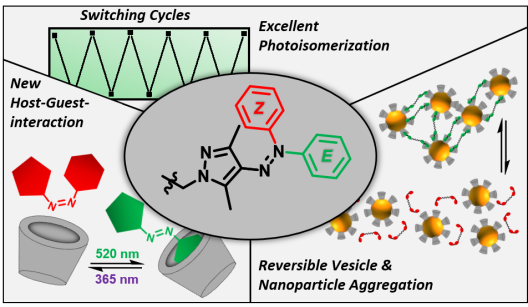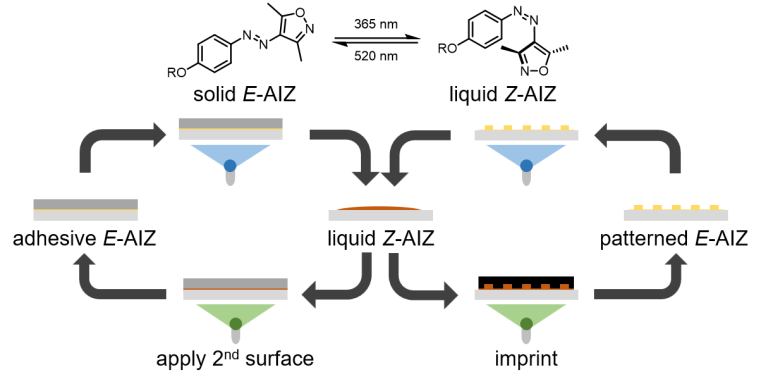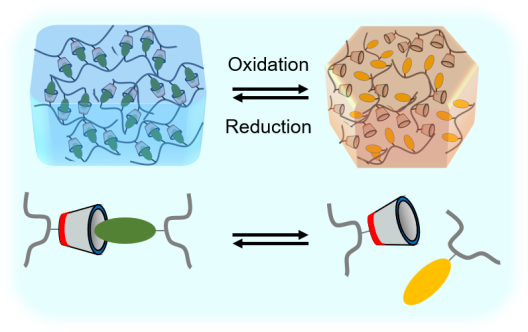Research
The “Synthesis of Nanoscale Systems” group was established in 2007 with the appointment of Prof. Dr. Bart Jan Ravoo. At that time, our group was one of three new groups founded at the University of Münster in the framework of the so-called FOKUS Initiative. The purpose of this initiative is to foster interfaculty links and collaboration between the disciplines of physics, chemistry and biology in the field of nanoscience and nanotechnology.
Our group is based in the Organic Chemistry Institute as well as in the Center for Soft Nanoscience (SoN). The group focuses on three main areas of research: biomimetic supramolecular chemistry, surface functionalization by molecular self-assembly and responsive materials. We develop new materials and chemical systems that are characterized by molecular organization on the nanoscale. Self-assembly is a key issue throughout our research.

One of our main topics is the creation of stimuli-responsive supramolecular assemblies composed of multiple small building blocks connected via multiple weak interactions such as host-guest complexes. Since these supramolecular systems are typically held together by highly multivalent interactions an excellent stimuli-response is needed to reach a switchable system. To this end, we introduced arylazopyrazoles (AAPs) as a new class of photochromic azo compounds that offer high yielding E/Z-isomerization in both directions by irradiation with light. Since AAPs show light-responsive host-guest interactions with beta-cyclodextrin they were applied in supramolecular soft materials composed of cyclodextrin vesicles or cyclodextrin decorated (nano)particles [J. Am. Chem. Soc. 2016, 138, 4547–4554]. With our expertise in this area, we are also extending the applications to other azo-based photoswitches, as we recently reviewed [Angew. Chem. Int. Ed. 2023, 25, e202304437].

Figure 2: Application of the solid-liquid phase transition of AIZs as adhesives (left) and reversible photoresist (right). [ACS Appl. Mater. Interfaces 2020, 12, 32054–32060]; [Small 2022, 18, 2203245].
© 2022 adapted with permission by the authors. Small published by Wiley-VCH GmbH.Also from a macroscopic perspective, photo-responsive materials are of interest. In this context, functionalized arylazoisoxazoles (AIZs) show fascinating behavior concomitantly with the photo-induced E/Z isomerization: a reversible solid-liquid phase transition can be triggered upon irradiation. This opens the door toward new applications. For example, we applied alkoxy-functionalized AIZs as photo-responsive adhesives [ACS Appl. Mater. Interfaces 2020, 12, 32054–32060]. Further, surfaces and their properties are of great technological importance and selective functionalization is required to obtain tailor-made properties such as tunable wettability or conductivity. Besides self-assembled monolayers and polymer brushes, again AIZs have shown to offer new opportunities: Liquid Z-isomers can be patterned with a micro-structured stamp and the structure is preserved upon photo-induced solidification. This approach further allows for application of the AIZs as a matrix for nanoparticles or as a protective layer for the underlying surface [Small 2022, 18, 2203245].

Hydrogels represent another class of soft materials that is within the focus of our research. In order to implement responsive behavior to hydrogels, we investigate supramolecular, polymeric and organic-inorganic-hybrid materials. To this end, responsiveness towards light of different wavelengths, oxidants, pH-changes, heat and even magnetic fields has successfully been installed. As for an example, a system of two polymers functionalized with cyclodextrin or ferrocene, respectively, can form a gel upon host-guest interactions between the polymer side chains. Supply of an oxidant leads to the formation of ferrocenium thereby disintegrating the supramolecular inclusion complex and inducing gel to sol phase transition. Under reducing conditions, the interactions between the polymers can be restored and the properties of the gel are recovered [Angew. Chem. Int. Ed. 2021, 60, 21062–21068].
Currently, our group is composed of about 25 people. Our work is supported by the University of Münster, Deutsche Forschungsgemeinschaft (DFG: Normalverfahren, CRC 1459, IRTG 2678, SPP 2171), Verband der Chemischen Industrie e.V. (FCI), Alexander von Humboldt Foundation, Deutscher Akademischer Austauschdienst (DAAD), European Union and Volkswagen Foundation.
Please check the list of publications for the latest results from our group!
